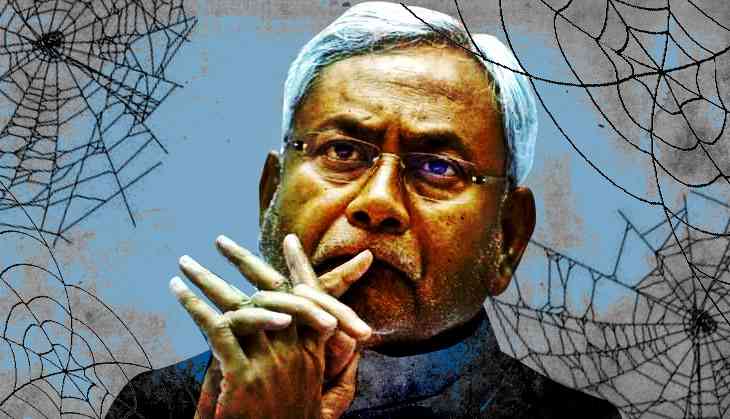How Nitish Kumar has been caught in a web of his own making

Bihar chief minister Nitish Kumar has got caught in a self-woven web. An over-ambitious Kumar, who also heads the Janata Dal-United (JD-U), had broken away from the erstwhile ruling Grand Alliance (GA) last year to return to the NDA in a bid to control the levers of power both in Bihar and the Centre. But his game is over.
The reason behind this trouble is Kumar himself. The way he has gone about dumping alliances midway, has destroyed his credibility. No one trusts him any longer. The result is that his own allies look at him with suspicion and are hesitant to spare a “fair” number of seats to the JD-U.
In the past five years, Kumar has switched sides three times, making him the most “unpredictable” politician of Indian politics.
It all started in 2010 when he won the Assembly elections with the BJP's support but three years later he broke alliance with the saffron camp to form government with the Opposition. In 2014, he resigned as Chief Minister and appointed Jitan Ram Manjhi as his replacement. But less than a year later, he removed Manjhi to come back as chief minister.
In 2015, he joined the three-party Grand Alliance and returned to power with the help of the RJD and the Congress but barely two years later—in July 2017—he dumped the GA to return to the BJP camp. As of now, the political scene is again agog with the news that Kumar is keen to return to the GA again.
So why this eagerness for GA now? The inside story is that the BJP has refused to spare too many seats for the JD-U given its current political stature and past track record. The JD-U is demanding a lion’s share of LS seats for Bihar and also insisting on finalising the seat-sharing deal on the basis of the 2015 Assembly polls when it had won 71 seats in the 243-member Bihar Assembly against the BJP which was able to win only 53 seats. But the BJP says the basis of the seat-sharing should be the 2014 LS polls when Kumar had gone it alone, wining only two seats out of Bihar’s total 40. The NDA, on the other hand, had emerged victorious on 31 seats—the BJP alone had bagged 22 seats while Lok Janshakti Party (LJP) and Rashtriya Lok Samata Party (RLSP) had won six and three seats respectively.
In the last LS polls, the BJP had contested 30 seats while seven and three seats had been given to the LJP of Ram Vilas Paswan and RLSP of Upendra Kushwaha respectively. Both Paswan and Kushwaha have refused to spare their allotted seats for the JD-U though the BJP has showed its willingness to leave five of the 30 it had contested last time for Kumar’s party. Given this situation, the JD-U could get a maximum of five seats to contest under the seat-sharing arrangement. It’s this apprehension of getting less number of seats which has caused panic in the JD-U camp, prompting it to use various pressure tactics to make a hard bargain.
Another reason being widely stated is that the BJP too is suspicious of Kumar’s activities and doesn’t trust him anymore. “The issue is not about sparing seats for Nitish Kumar. The real issue is that no one is sure how long he will stay with the NDA. In that case, the seats allotted to JD-U will turn useless,” said a BJP leader seeking anonymity.
Apparently, it was under in this context that the chief minister called up ailing RJD chief Lalu Prasad last week. Prasad is now recuperating in a Mumbai hospital. The idea, as such, was to put pressure on the BJP in a bid to gain maximum number of LS seats for Bihar but the RJD sought to spoil this plan by displaying a “No Entry” board for Kumar in the GA.
The RJD which enjoys the massive support Muslims and Yadavs, faces the risk of losing its own votes in the event of the chief minister returning to the GA again. In the last one year since Kumar ditched the GA, the RJD has launched an intense agitation against Kumar across the state, charging the latter with “misusing the people’s mandate”. Its impact was tremendous. Bihar Opposition leader Tejashwi Yadav, Lalu’s “political heir”, was greeted with a huge crowd wherever he led the protest. So if the RJD welcomes Kumar into GA, it is likely to boomerang.
Given that it has no option, the JD-U would be compelled to stay in the NDA.
By making frequent somersaults, Kumar has spoiled his own case.
As his last attempt, Kumar has announced that the JD-U will be contesting the upcoming elections in Rajasthan, Madhya Pradesh and Chhattisgarh on its own. But this is unlikely to change the BJP’s stand. The BJP is aware of the fact that the JD-U doesn’t have a presence anywhere except Bihar. Recently, the JD-U had contested elections in Gujarat and Karnataka but most of its candidates forfeited their security deposits.
Even in Bihar, Kumar's popularity has suffered and he has survived mainly with the support of his allies. Past records indicate that Kumar has suffered serious setbacks whenever he chose to go it alone. This was proven first in the 1995 Assembly polls when the Kumar-led Samata Party was able to win only seven seats in the 324-member assembly in undivided Bihar. Again in 2014 LS polls, Kumar decided to go it alone but ended up winning only two out of 40 seats his party had contested. Kumar is, thus, short of options.

